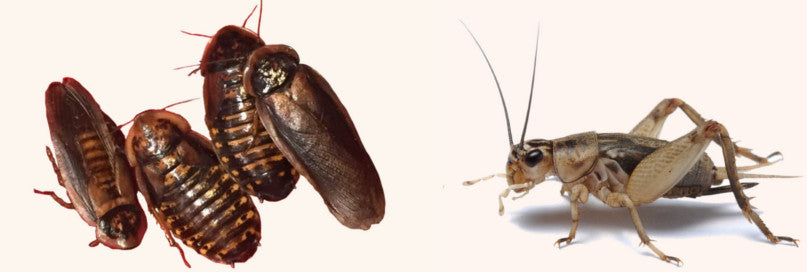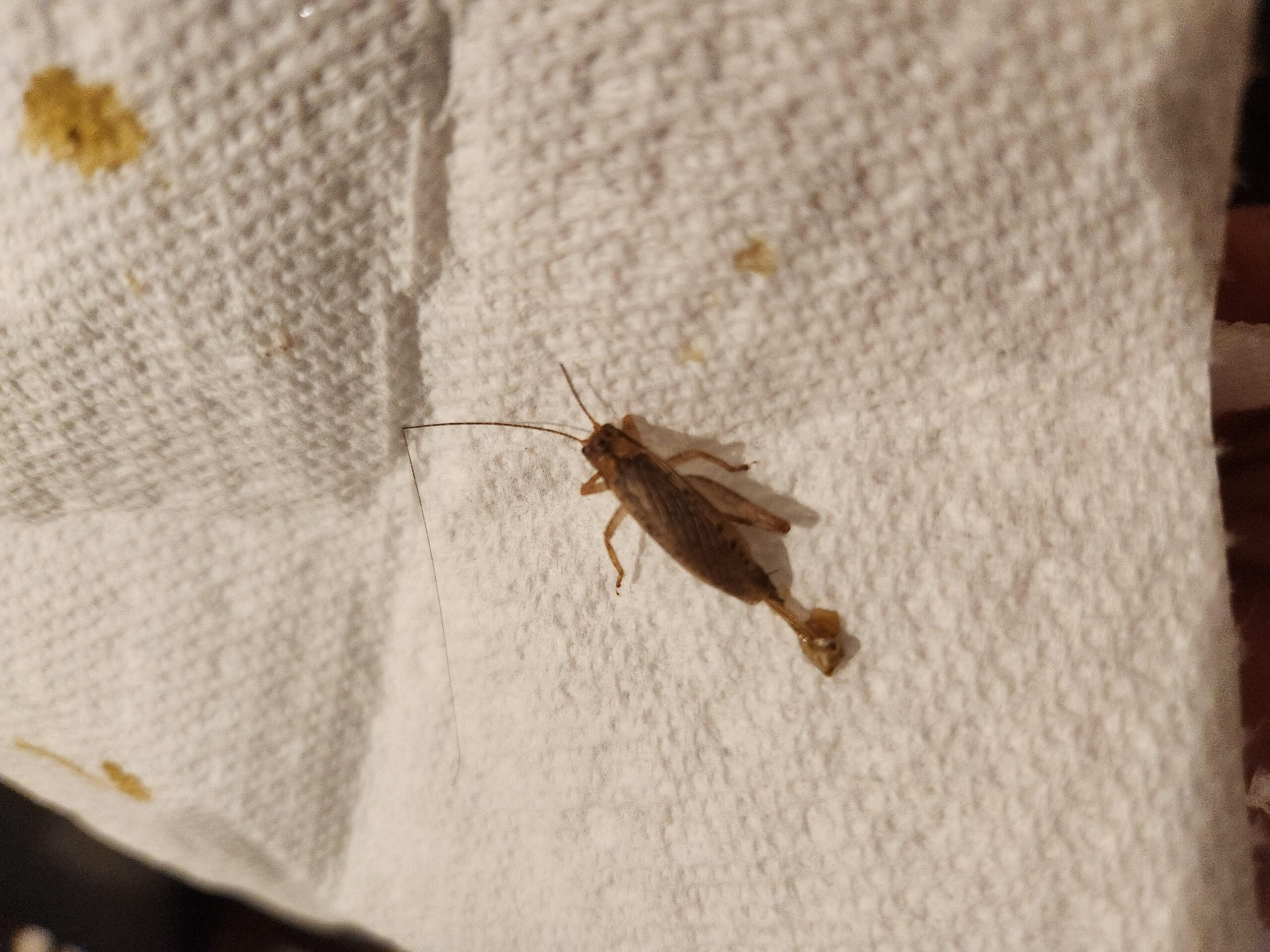When it comes to distinguishing between a cockroach and a cricket, look for the wings and long legs on crickets, while cockroaches have shorter legs and a hard shell. Crickets and cockroaches have distinct physical differences and behaviors that set them apart.
Crickets are known for their ability to jump, with long, bent hind legs, while cockroaches have a flattened, oval-shaped body and are more likely to scavenge for food. Additionally, crickets have a different diet, preferring plant matter over meat, and are not commonly found in kitchens or bathrooms like cockroaches.
Understanding these differences can help in identifying and controlling these pests effectively.

Credit: www.thecritterdepot.com
Physical Characteristics
Crickets have wings in front and long legs for jumping, while cockroaches have shorter legs and a hard shell for protection. Their physical characteristics distinguish them from one another.
Physical Characteristics: Cockroaches and crickets are both insects, but they have some distinguishing physical characteristics that set them apart. Let’s take a closer look at the physical features of these two insects. Identifying Traits of Cockroaches: Cockroaches have a flattened, oval-shaped body that is low to the ground. They have six legs and two antennae, which they use for sensing their environment. Cockroaches also have a hard exoskeleton that protects their body. They come in different sizes and colors, ranging from brown to black, with some species having stripes or spots. Distinguishing Features of Crickets: Crickets have a different body shape compared to cockroaches, with an elongated body and very large, bent, back legs that set them apart. They have six legs and two antennae like cockroaches, but also have wings that are located in front of their body. Crickets use their wings for flight and long legs for jumping. They come in various colors, including green, brown, and black. In conclusion, while both cockroaches and crickets share some similarities, such as their six legs and antennae, they have distinct differences in their physical characteristics. Cockroaches have a flattened, oval-shaped body with a hard exoskeleton, while crickets have an elongated body with large, bent back legs and wings. Knowing these identifying traits can help distinguish between the two insects.
Behavioral Differences
When it comes to behavioral differences, cockroaches and crickets exhibit distinct characteristics in their dietary habits and movement patterns. Understanding these differences is essential in identifying and managing potential infestations.
Dietary Habits
Cockroaches are opportunistic feeders, consuming a wide range of organic matter including food scraps, paper, and even glue. Their omnivorous nature allows them to thrive in various environments, making them resilient pests. On the other hand, crickets are primarily herbivorous, feeding on plant matter, fruits, and occasionally small insects. Their dietary preferences often lead them to outdoor habitats, away from human dwellings.
Movement Patterns
Cockroaches are adept at hiding and navigating tight spaces, utilizing their flattened bodies to slip through cracks and crevices. Their nocturnal behavior enables them to remain hidden during the day, emerging at night to forage for food. Conversely, crickets are known for their distinctive chirping and jumping abilities, using their powerful hind legs to propel themselves away from predators and towards potential mates. Their diurnal habits often bring them into contact with humans, especially in outdoor settings.
Sound And Communication
Sound and communication play crucial roles in the lives of insects, including cockroaches and crickets. Both of these insects produce sounds for various reasons, such as attracting mates, warning off predators, or establishing territory. Understanding the different sounds and communication methods of cockroaches and crickets can provide valuable insights into their behavior and biology.
Chirping And Stridulation
One of the most distinctive features of crickets is their ability to produce a chirping sound through a process called stridulation. This sound is created when the male cricket rubs its wings together, producing a high-pitched chirping noise. The purpose of this sound is primarily to attract females and deter rival males. In contrast, cockroaches also produce sounds through stridulation, but the sound they produce is significantly different from that of crickets.
Distinguishing Insect Sounds
It is essential to be able to distinguish between the sounds made by cockroaches and crickets. While both insects use stridulation as a form of communication, the specific frequencies and patterns of the sounds they produce are distinct. Crickets’ chirping tends to be rhythmic and repetitive, while cockroaches’ stridulation produces a more irregular and intermittent noise. Being able to differentiate between these sounds can help in identifying the presence of either insect in a given environment.
Habitat And Infestation
Cockroaches have a harder shell and shorter legs, while crickets possess long legs for jumping and wings in front. Their distinct body features set them apart in habitat and infestation scenarios.
Habitat and Infestation: Cockroaches and crickets are two common household pests that are often confused with each other. While both insects can cause problems when they invade homes, they differ in their preferred environments and signs of infestation. Let’s take a closer look at these differences.
Preferred Environments
Cockroaches prefer warm, moist environments, such as kitchens, bathrooms, and basements. They are attracted to areas with food and water sources and can often be found hiding in cracks and crevices. They are nocturnal insects and tend to be more active at night. On the other hand, crickets prefer dry, cool environments, such as basements, crawl spaces, and garages. They are attracted to light and can often be found near windows and light fixtures. They are also nocturnal insects and tend to be more active at night.
Signs Of Infestation
Signs of a cockroach infestation include the presence of feces, egg cases, and shed skins. Cockroach feces are small, dark, and cylindrical in shape, and can often be found near their hiding places. Egg cases are small, brown, and oval in shape, and can be found in crevices and cracks. Shed skins are also a common sign of a cockroach infestation, as the insects shed their skin several times throughout their life cycle. Signs of a cricket infestation include the presence of chirping sounds and damage to fabrics and paper products. Male crickets chirp to attract females, and their chirping can often be heard at night. Crickets also feed on fabrics and paper products, and their feeding can result in holes and damage to these materials. In conclusion, understanding the preferred environments and signs of infestation of cockroaches and crickets can help homeowners identify and address pest problems in their homes. Regular cleaning, sealing cracks and crevices, and proper storage of food and paper products can help prevent infestations of these pests.
Impact On Humans
Both cockroaches and crickets can have significant impacts on humans. Let’s explore the various ways in which these insects affect human health and property.
Health Concerns
Cockroaches can pose serious health risks to humans as they are known carriers of pathogens, including bacteria, viruses, and parasites. Their presence in homes can lead to allergies, asthma, and other respiratory issues. Additionally, cockroach feces and shed skin can trigger allergic reactions in some individuals.
On the other hand, crickets are not known to directly transmit diseases to humans. However, their chirping can cause sleep disturbances, leading to stress and anxiety.
Property Damage
Cockroaches are infamous for causing property damage. They can contaminate food, leave behind foul odors, and stain surfaces with their excrement. Additionally, cockroaches can damage books, clothing, and electronic devices by feeding on them.
Crickets, while not as destructive as cockroaches, can still cause damage to fabrics and paper products through their feeding and nesting habits.

Credit: www.reddit.com
Prevention And Control
Cockroaches and crickets can be unwelcome guests in your home, but with proper prevention and control methods, you can keep these pests at bay.
Natural Control Methods
- Keep your home clean and free of food crumbs and spills to eliminate food sources for pests.
- Seal cracks and crevices in walls, floors, and around pipes to prevent entry.
- Use diatomaceous earth, a natural insecticide, in cracks and crevices as a barrier.
- Plant pest-repelling herbs like mint, basil, or lavender around your home.
- Set up sticky traps to catch and monitor pest activity.
Professional Pest Management
- Consult with a pest control professional for a thorough inspection and treatment plan.
- Consider professional pest control services for severe infestations.
- Implement integrated pest management techniques for long-term control.
- Regularly schedule follow-up visits to ensure the effectiveness of treatments.

Credit: www.reddit.com
Frequently Asked Questions
How Can You Tell The Difference Between A Cricket And A Roach?
You can tell the difference between a cricket and a roach by looking at their physical features. Crickets have wings in front and long jumping legs, while roaches have shorter legs and a hard shell.
Will Crickets Eat Roaches?
Crickets do not usually eat roaches as they have different diets and behaviors.
How To Tell If A Bug Is A Roach?
To tell if a bug is a roach, check for flat, oval body, long legs, and antennae. Roaches have a hard shell and move quickly.
Conclusion
In distinguishing between crickets and cockroaches, remember crickets have wings and long legs for jumping. Cockroaches have shorter legs and a hard shell. Understanding their differences can help in pest control. Identifying these insects correctly is essential for effective management.
Related posts:

I’m MD Tanvir, and I bring years of expertise gained from working closely with pest control companies to the forefront. My journey in the industry has inspired me to launch Bug Battler, a platform aimed at equipping people with the know-how to combat pests autonomously. Through Bug Battler, I aim to empower individuals with practical insights to tackle pest infestations effectively.

